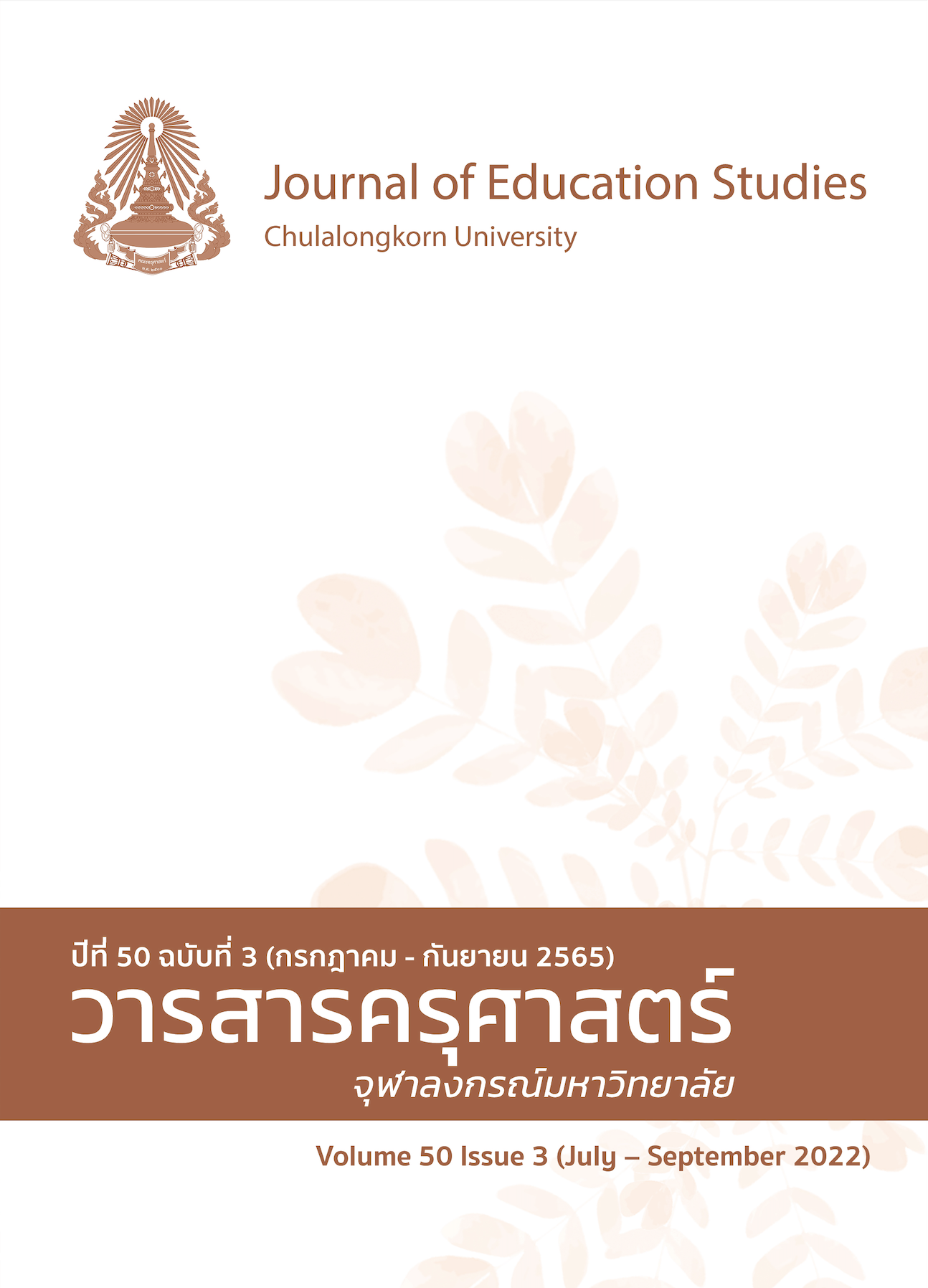Effects of Using a Concept Attainment Model with Graphic Organizers Technique to Enhance the Concept Formation Abilities of Kindergarteners
DOI:
https://doi.org/10.14456/educu.2022.20Keywords:
concept attainment model, graphic organizers, concept formation abilities, kindergartenersAbstract
The purposes of this research were 1) to study the effectiveness index of lesson plans using the concept attainment model along with graphic organizers technique; 2) to assess and compare kindergarteners’ concept formation abilities before and after the experiment. The research participants consisted of 20 kindergarteners aged 5 to 6 years. Each 60-minute experimental session was executed four times a week for a total period of six weeks. The lesson plans were implemented through three main phases: 1) preparation; 2) experience organization (warm up, concept presentation, data organization, concept summary, and individual graphic organizer creation); and 3) evaluation. The research instrument used was a performance rubric for the kindergarteners’ concept formation abilities. Statistical analyses used in the present study were the effectiveness index and calculations for mean, standard deviation, and t-test. The major findings were as follows: 1) the index of effectiveness of the lesson plans was equal to 0.8511, indicating that the participants showed an 85.11 percent improvement in their concept formation abilities; 2) the concept formation abilities of kindergarteners after the experiment were significantly higher than before the experiment at the .05 level of significance. The results of this research indicate that using a concept attainment model along with graphic organizers technique can enhance the concept formation abilities of kindergarteners.
References
ภาษาไทย
กระทรวงศึกษาธิการ. (2560). หลักสูตรการศึกษาปฐมวัย พุทธศักราช 2560. ชุมนุมสหกรณ์การเกษตรแห่งประเทศไทย.
ทิศนา แขมมณี. (2553). ศาสตร์การสอน : องค์ความรู้เพื่อการจัดกระบวนการเรียนรู้ที่มีประสิทธิภาพ (พิมพ์ครั้งที่ 12).
ด่านสุทธาการพิมพ์.
นาตยา ปิลันธนานนท์. (2542). การเรียนรู้ความคิดรวบยอด. มหาวิทยาลัยเกษตรศาสตร์.
นลินรัตน์ ทับทิมทอง และ บัณฑิตา อินสมบัติ. (2558). ผลการใช้ชุดการสอนโดยใช้กระบวนการสร้างความคิดรวบยอดที่มี
ต่อความสามารถพื้นฐานทางคณิตศาสตร์ด้านจำนวนของเด็กปฐมวัย [วิทยานิพนธ์ปริญญามหาบัณฑิต ไม่ได้ตีพิมพ์].
มหาวิทยาลัยราชภัฏนครสวรรค์.
ธัญญา ผลอนันต์. (2550). Mind map กับการศึกษาและการจัดการความรู้. ขวัญข้าว 94.
ปรียาพร วงศ์อนุตรโรจน์. (2553). จิตวิทยาการศึกษา. พิมพ์ดี.
มานพ สิงห์วี และ บัญญัติ ชำนาญกิจ. (2556). ผลการสอนโดยใช้เทคนิคผังกราฟิกประกอบรูปแบบสืบเสาะหาความรู้ที่มีต่อ
ผลสัมฤทธิ์ทางการเรียนวิชาฟิสิกส์และความคงทนในการเรียนรู้ของนักเรียนระดับชั้นมัธยมศึกษาปีที่ 4.
วารสารวิชาการและวิจัยสังคมศาสตร์, 8(23), 115-128.
วัฒนา มัคคสมัน. (2560). แนวคิดเกี่ยวกับนวัตกรรม สื่อและเทคโนโลยีทางการศึกษาปฐมวัย. มหาวิทยาลัยสุโขทัยธรรมาธิราช. (ม.ป.ท.)
วิชัย วงษ์ใหญ่ และ มารุต พัฒผล. (2562). การจัดการเรียนรู้เพื่อเสริมสร้างความคิดรวบยอด. ศูนย์ผู้นำนวัตกรรมหลักสูตรและการเรียนรู้.
วรนาท รักสกุลไทย. (2561). การใช้ผังกราฟิก เพื่อพัฒนาเด็กปฐมวัย. แปลน พริ้นท์ติ้ง.
ศรีสุข ชีพพานิชย์. (2553). การใช้รูปจำลองสี่เหลี่ยมจัตุรัสเพื่อสร้างความคิดรวบยอด เรื่อง การคูณและการหารเศษส่วนของ
นักเรียนชั้นประถมศึกษาปีที่ 5 [วิทยานิพนธ์ปริญญามหาบัณฑิต ไม่ได้ตีพิมพ์]. มหาวิทยาลัยเชียงใหม่.
ศิรประภา พฤทธิกุล. (2556). หน่วยที่ 6 การจัดกิจกรรมการเล่นสำหรับเด็กปฐมวัย. ใน พัชรี ผลโยธิน (บ.ก.), เอกสารการสอนชุดวิชา การเล่น
ของเล่น และเครื่องเล่นสำหรับเด็กปฐมวัย. (น. 6-1 - 6-82). สำนักพิมพ์มหาวิทยาลัยสุโขทัยธรรมาธิราช.
สำนักงานคณะกรรมการการศึกษาขั้นพื้นฐาน. (2562). รายงานผลการประเมินพัฒนาการนักเรียนที่จบหลักสูตรการศึกษาปฐมวัย พุทธศักราช
ปีการศึกษา 2561. อักษรไทย.
สำนักงานเลขาธิการสภาการศึกษา. (2563). รายงานการศึกษาสภาวการณ์การจัดการศึกษาสำหรับเด็กปฐมวัยในประเทศไทย.
พริกหวานกราฟฟิค.
สุวิทย์ มูลคำ. (2559). กลยุทธ์การสอนคิดเชิงมโนทัศน์. ภาพพิมพ์
อดุลย์ วังศรีคูณ. (2557). การศึกษาไทยในศตวรรษที่ 21 : ผลผลิตและแนวทางการพัฒนา. วารสารมนุษยศาสตร์และ
สังคมศาสตร์. บัณฑิตวิทยาลัย มหาวิทยาลัยราชภัฏพิบูลสงคราม. 8(1), 1-17
ภาษาอังกฤษ
Arends, R. I. (2001). Learning to teach (5th ed. ). McGraw-H.
Ausubel, D. P. (1968). Educational psychology: A cognitive view. Rinehart and Winston.
Clark, H. (1991). Using visual organizer to focus on thinking. Journal of Reading, 34(7), 526–534.
Carroll, W. (2007). The concept attainment model. http://www.lcsc.education/secondary/courses/ED454/
Lessons/OnCampus06Chapter5.pdf
De Cecco, J. P. (1968). The psychology of learning and instruction: Educational psychology. Prentice-Hall.
Eisner, S. P. (2005). Managing generation Y. SAM Advanced Management Journal, 70(4), 4-15.
Jones, B. F., Pierce, J., & Hunter, B. (1989). Teaching students to construct graphic representations.
Educational Leadership. 46(4), 20-25.
Joyce, B., & Weil, M. (1996). Model of teaching. Allyn and bacon.
Kurniaman, O. (2018). Reading comprehension skill using graphic organizer for elementary school students.
Journal of Teaching and Learning in Elementary Education (JTLEE), 1(2), 75-80.
Downloads
Published
How to Cite
Issue
Section
License

This work is licensed under a Creative Commons Attribution-NonCommercial-NoDerivatives 4.0 International License.




